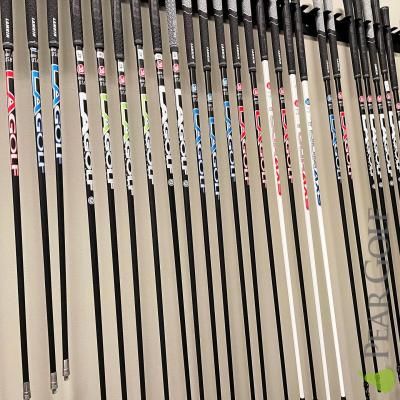

科技日新優異下,我們可以明顯感覺到球桿變得越來越好打,容錯也比以前要好。這個在桿頭上是無庸置疑,但對於桿身這部分來說,是否如同桿頭那樣的明顯進步?用另一個問法,桿身是否對於現在木桿的易打、容錯也是有至關重要的因素?我以前有寫過一樣的文章,今天這篇是以近10年的桿身款式,和實際使用心得來分析。一般人其實很難去分析和感受桿身的差異,如果你沒有很多木桿,同時搭配不同款式和同一個款式,但不同新舊、不同的型號,甚至同一個款式、同一個重量,但不同新舊款。
一個前提是,我所說的桿身都是以aftermarket(桿身品牌自己生產銷售產品),不是貼牌的OEM/代工產品。總之,如果球友沒有很多的桿身來進行比較,是很難瞭解桿身之間的差異。我從20年前就開始用Fujikura桿身到現在,主要針對它們speeder系列,和近10年來的Ventus系列/紅、藍、黑三款,有深入使用經驗,所以可以提供我自己的使用心得來分享給大家。我自己時不時,都會把之前的桿身,裝在現在新的木桿桿頭上,比較整體使用的差異。這也是我覺得值得讓大家瞭解真實的球桿性能。
我在過去20年裡,使用過Matrix/LAGP(全系列)、三菱(部分系列)、Fujikura(Speeder和Ventus)結合為主的桿身品牌,所以得到一些經驗和結論。桿身本身沒有好壞、對錯問題,只有適合與否!必須以你本身使用和揮桿方式來選擇適合你的產品,同時也需要根據桿頭本身特性,來配置桿身優勢。另外還需要以使用者生理條件和能力為基礎,去配置最好的球桿規格。缺一不可、不是貴的桿身就一定有超猛的性能和手感。
當你的球桿都滿足以上的條件下,才能觀察和感受桿身新舊款式差異。因為如果球桿規格配置不對、桿頭特性選擇錯誤、桿身重量、硬度選擇不正確,你就無法感受到桿身真正的性能與回饋。我組裝過很多木桿、球道木、鐵桿、挖起桿和推桿。大部分都可以得到最好的結果,但有時也會走莖。用起來就不是很舒服,結果和我其他球桿有明顯差異。
而我後面也會重新設定球桿,來找出桿身設定最佳化,比如換不同特性桿頭、更改桿身長度、調整球桿整體重量、硬度,和更換不同特性/重量的握把來進行優化。結果真的就完全不同,這就可以讓一支桿身完全重生。所以別小看球桿的細節,一個設定、選擇錯誤,就可以讓結果和回饋上下顛倒。因為當我打了球桿,自然可以敏感的抓出哪個環節不對,和需要如何去調整、改善。
本文未完,中集請點下方。
桿身的新舊款真的有差嗎/Is shaft verison really matter for hitting results?~中集
https://www.peargolf.com/article/ganshendexinjiukuanzhendeyouchaimais-sh...
桿身的新舊款真的有差嗎/Is shaft verison really matter for hitting results?~下集
https://www.peargolf.com/article/ganshendexinjiukuanzhendeyouchaimais-sh...
With the rapid advancement of golf technology, we can clearly feel that clubs are becoming easier to hit and more forgiving than before. This is especially true for the clubheads. But when it comes to shafts, have they improved just as much? I did write the same topic in the past, but it's the update of recent 10 years shaft's development. To put it another way, are shafts just as important as heads when it comes to making modern woods easier to hit and more forgiving?
For most golfers, it's hard to really analyze or feel the difference in shafts—especially if you don’t have access to a lot of different woods, or if you haven’t tried the same model with both older and newer shaft versions. Sometimes even the same shaft model and weight can perform differently just because of its version and generation.
So in short, unless you've tried a wide variety of shafts, it’s not easy to truly understand their differences. I’ve been using Fujikura shafts for the past 20 years, especially the Speeder series and, more recently, the Ventus series over the last decade. I’ve gained a lot of hands-on experience with them, and I’d like to share some of my insights. I also often pair older shafts with new clubheads to compare how they perform as a full setup—this helps me better understand the real performance of each component.
Over the past two decades, I’ve mainly used shafts from Matrix/LAGP (all series), Mitsubishi (some series such as Diamana), and Fujikura (Speeder and Ventus). From that, I’ve learned one thing: there’s no such thing as a “good” or “bad” shaft—only the right or wrong fit for you. The right shaft depends on your swing style and how you use your clubs. It also needs to match the characteristics of your clubhead, and be suited to your physical condition and ability. You need all of those elements working together—just buying an expensive shaft doesn’t guarantee great performance or feel.
Only when your club setup is dialed in correctly can you really start to notice the differences between older and newer shaft designs. If your specs aren’t right—if the clubhead doesn’t suit you, or the shaft weight or stiffness is off—you won’t be able to feel what the shaft is truly capable of. I’ve built a number of drivers, fairway woods, irons, wedges, and putters. Most of the time I receive great results, but sometimes a setup just doesn’t work—it doesn’t feel right, and the performance drops off compared to other clubs.
That’s why I often go back and tweak the shaft settings to find the best performance—changing the clubhead, adjusting the shaft length/ the flex, tweaking the overall weight, or swapping grips with different materials or weights. And the results can be drastically different. It’s like giving a shaft a new life. So don’t overlook the small details in your club setup—a wrong choice or setting can completely flip the feel and performance. Because when I swing a club, I can immediately sense which part isn’t right and know what needs to be adjusted or improved.
Is shaft verison really matter for hitting results?~Part II
https://www.peargolf.com/article/ganshendexinjiukuanzhendeyouchaimais-sh...
Is shaft verison really matter for hitting results?~Part III
https://www.peargolf.com/article/ganshendexinjiukuanzhendeyouchaimais-sh...
請尊重本站內容智慧財產權.勿未經洋梨高爾夫同意下進行非法轉載文章!如想進行文章轉載需求,請與下面電郵聯系!
本站在Facebook/臉書上的帳號被駭了,所以乾脆就結束。要申訴太累也沒有對應程序,就把內容放著本站裏。感謝大家支持。謝謝
- 如果想要發表回應,請先登入。


